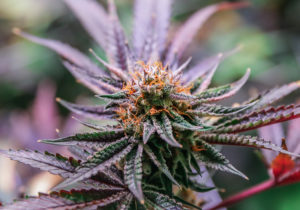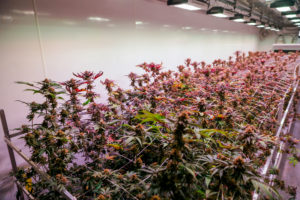Sam Vilifshi Indoor Cannabis Labs Interview
Sam Vilifshi Interview – Master Cultivator at Micro Lab Farms
We Interview Sam V, the master cultivator at Micro Lab Farms on why they prefer growing indoor lab settings vs outdoor, and discuss the future of medical cannabis grows.
Introduce Yourself…
My name is Sam Vilifshi, I’m the master cultivator here at Micro Lab Farms.
Basically I’m handling not only the operations of the actual grow, but also the execution. They go hand in hand and if you don’t have your hand on the pulse with what’s going on with these plants on a day to day basis, I’m not really able to give them what they need because it changes so rapidly.
What’s a Micro Lab – Indoor Container Farm?
This is our stacker model. Essentially what you’re able to do is be able to grow potentially twice as much production as you would in a single stack pod in a vertical farming method.
Why LEDs? What happened to HIDs?
We have these LED full-spectrum lights: that’s really what allows us to maximize the space. When you use LED lights there’s a lot less heat being pushed out by those lights so you don’t need them to be as far away from the plants.
That’s why you notice, when you look at these, they’re like literally almost like a couple inch or two inches away from the actual light.
When you’re using HIDs or metal halide or high pressure sodium you need at least 24
inches away from those plants so you’re not burning your tips. By doing that also
though there’s a lot of different factors that play into that.
When you have less heat you have to make sure that your temperature in your pod
is a lot higher ,so we have these two AC units. We have humidifiers and dehumidifiers in the back and those are all connected to a smart system.
How does the smart system work?
Over there that essentially gives us the stats every single second, even if we’re not here, and there’s different alarms and different settings on that smart system, so that if something goes off or something is not exactly where we needed to be, we can adjust it without even necessarily having to be here.
How many plants can you fit in a container?
On top of that we’re able to plant a sea of green style, so we fit maybe 600 plants in here, whereas when you’re doing in a basic model you’re only able to fit 100 to 120 plants, so you’re really able to maximize your production and maximize your resin quality because you’re using LEDs.
How do you water the plants?
In the rear of the cans there’s reservoirs, or if you want to set up a fully automatic water drip system, you will be able to line all your plants out and essentially reduce your manpower by 50 percent.
Airflow?
We also have huge Shaffer fans in the back to make sure we have proper air flow to make sure that we’re mitigating our powdery mildew issues and ensuring that these buds are getting as much resin production as they possibly can and they’re getting really sturdy as well.
All these different environmental factors really play a huge role, especially when you’re
in a contained space because these plants grow naturally outside. They get the wind, they get the rain they get the sun and if you’re not really dialing in all those different things you get a mediocre bud.
Difference between a container and a lab setting?
I’ve worked in other shipping containers where essentially people took shipping containers and tried insulating them and throwing lights in there and making the most of it, and when you do it that way there’s a lot of variables that aren’t answered.
“Are you actually fully sealed?”
“Was the shipping container decontaminated before you converted it?”
Because you have to worry about mold issues, fungus issues, bug issues, all these different contaminants.
This truly is a laboratory setting.
I’ve never worked in a shipping container or even a grow that’s been fully converted as clean as this. And cleanliness really is one of the pinnacle points of being able to have a successful growth, because you can have amazing buds, you can have amazing genetics, but if you have mold issues or if you have bug issues, all that can really go to waste.
At the end of your grow, to really have engineers and have a lights like this, this really changes your ability to maximize your plant.
 How to maximize bud weight?
How to maximize bud weight?
Typically when you have a plant like this there’s gonna be a lot more leaf and a lot less bud, because that leaf is protecting the plant from the high heat and from the high intensity light.
When you’re using LEDs you end up having to strip away a lot more leaves,
and in doing so you end up getting a lot more buds, a lot more weight out of it.
That’s why a lot of people talk about already is getting potentially twice as much weight as a HID light would get.
On top of that the smart system being able to have your pulse and your eye on exactly what’s going on.
How does technology hedge against crop failure?
Every second is priceless because at any given moment something can happen to these plants: you don’t know if the lights go out, if the fans go out, if the humidifier stops working, and all of a sudden it’s 90 percent humidity in here.
I’ve seen a lot of people lose crops and and really lose production just on one mistake happening in one day and they couldn’t get to it within that minute or that hour, because if you’re not in your grow every single second and every single moment, there’s always a potential for failure.
When you have a smart system and you have all these different automatic systems set up there’s a lot less chance for failure.
Outdoor vs indoor?
When you grow outdoors there’s guaranteed to be mold and bugs. It’s more about accepting the fact that you’re in an outdoor environment, you’re not in the laboratory setting when you’re dealing with the environment.
What you’re trying to do is control that environment with the best route, to the best of your ability, and sometimes that means that you do have to section off in 14 different areas to make sure that doesn’t get the rest of your crop, but you’re not going to necessarily get rid of it.
When you’re working in a laboratory setting like this, in a controlled environment,to be able to control every step of the process from clone, to plant, to harvest, the potential from having bugs always to having zero bugs is really the difference you can have to a full grow and never see mold, never see a bug once in an indoor setting.
In an outdoor setting there’s no possibility that you’re never gonna see a bug and you’re never going to see mold, it’s just not possible.
The quality of bud, when not only growing indoor, but when growing with LEDs, is that I’ve never seen the resin production that I’ve seen under LEDs. These plants are completely coated and with HIDs you can get that to a certain extent, but you
don’t also get the same weight because you have to de-leaf to be able to get light penetration all the way down to the bottom. You will be able to get that intensity without those heat problems.
These plants don’t stress out, and not only they are getting super resinous buds, but also you’re getting fist-sized buds.
And when you compare that to outdoor, you know that you’ll get the mass and the quantity of buds, and you can grow plants that are the size of a building
but they’ll never have the resin quality and they’ll never have the terpene production.
Who are these container farms for?
The ideal fit is anybody from boutique to full commercial farming in shipping containers. If you’re planning on growing indoor and you plan on growing high-quality buds because the difference between indoor and outdoor really comes to resin quality.
How does the quality compare?
Interpreting quality when you’re growing outdoor: you’re growing for mass production.
A lot of times there’s different people doing attraction for that and they’re throwing away a lot of the actual flower.
When you’re growing indoor this flower is really, by far, the most exceptional flower that you will find. You get much better control and you also get higher intensity light.
When you’re doing the sun, you get a broader spectrum potentially but you don’t get the same intensity and and when you talk to the customer, as far as what type of fit this would be for different growers, really if you’re doing boutique style.
It’s perfect because you get to control your environment. You get to have an individual
space that’s designated just for that grow. You’re not going to be bringing in outside contaminants, you’re not gonna be bringing outside problems and if you want to really have that super high quality flower that’s really what you need to do.
Pre-fab vs DIY builds?
When you go into a facility, and you go into a building, and you need to turn that into a grow, you essentially have to reef at that whole entire building, you have to tear down everything that’s in there, you have to remove the foundation.
If you set up irrigation systems, you essentially have to tear down the building without tearing it down, and then rebuild it so that it can actually be a grow.
When you get a pod like this it’s already prefabricated. All you have to do is place this pod in your building and you already have it set up, so if you end up having to move
or go to a different place you don’t have to worry about the fact that you completely destroy the building on the inside, lose potentially down payments on the facility, lose time and money on engineers and electricians and plumbers.
You can take those pods and move them to any facility. You move out of state, you can move them out of state. You move them out of the country, you can move them out of the country. It’s really genius!
What is the future of medical cannabis production?
I think if we’re going to talk about the future of marijuana growing. I think shipping containers really is the best route for a couple different reasons.
In California we have like these beautiful seasons all year round and some people can grow plants sensibly all year round with some supplemental lighting, but when we start
expanding to other states and this becomes federally legal, you don’t get those same summer months essentially all year round.
You have monsoons, you have tornados, you have hurricanes, you have snow, you have ice, you have all these different issues. And if you’re able to grow inside a shipping container, you’re able to grow five harvests a year or you able to perpetually grow and always keep that that revenue going.
On top of the fact that if for some reason something happens to your building or if you have to move or if something changes and you expand even further, you have these essentially mobile grow pods that you’re able to take anywhere with your business.
It’s a one-time investment that you don’t have to keep on tearing down and rebuilding
every single time something new happens in your business.

About Sam
Sam Vilifshi is the master cultivator at Micro Lab Farms. A manufacturer of shipping container farms based in Needles, CA who specializing in building modular grow environments for medical cannabis and hemp.
